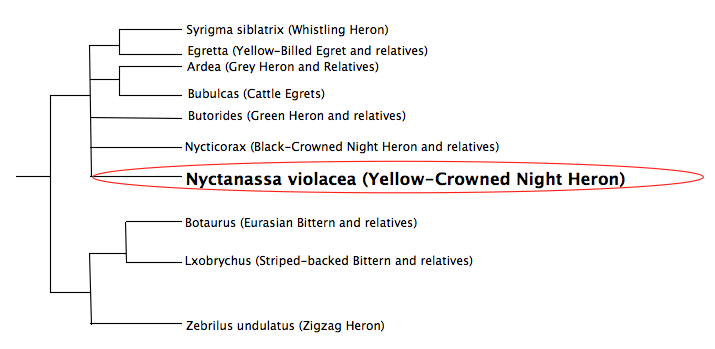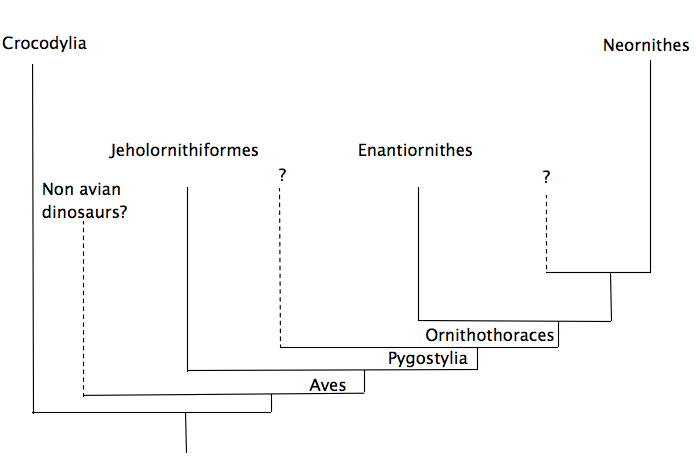Classification
Domain: Eukarya
Kingdom: Animalia
Phylum: Chordate
Class: Aves
Order: Pelecaniformes
Family: Ardeidae
Genus: Nyctanassa
Species: Nyctanassa violacea

Figure 1.1. This phylogenic tree displays relationships between different herons in the Ardeiae family. The yellow-
crowned night heron form their own apomorphic branch and are most closely related to Nycticorax and
Butorides (Sheldon et al. 2000).
The yellow-crowned night heron belongs to the domain Eukarya, or
organisms with cells containing a nucleus and membrane bound organelles.
Further down we see they fall in the kingdom Animalia, because of their
multicellularity, lack of cell walls and mobility. Further into the
animal kingdom we see they belong to the phylum Chordate, because they
have organized tissues, are triploblastic, deutersomes, and possess a
notochord. In the yellow-crowned night heron this is seen as a vertebrae
made of bone or osseous tissue.
Night herons belong to the class Aves (or clade Avialae) meaning they
are feathered, winged, two-legged, warm blooded and lay hard shelled
eggs. This is what we would typically think of as a "bird" (Van Tuinen
2009; Hackett et al. 2008). Other species in this class include the
Harpy Eagle
and the
Vampire Finch .
More specifically, the yellow-crowned night heron belongs to the
sub-class Neornithes, the most recent common ancestor of all living
birds. Traits observed by these modern birds would be a beak without
teeth and a high metabolic rate and rate of growth (Clarke 2004).
Neorinthes would be considered modern birds, except Palaeognathae
(mostly flightless birds) such as Apteryx haastii (Great
Spotted Kiwi) and Galloanserae (land and water fowl) such as
Gallus gallus (Common
domestic Chicken) (Feduccia 1999). This sub-clade has over 9500
species defined into 20-28 different orders (Van Tuinen 2009).
The yellow-crowned night heron is put into the class Neoaves, an order
that separates land and water fowl from all other birds. Within the
Neoaves class, night herons are described in the order of
Pelecaniformes, meaning they are medium and large sized waterbirds. This
class was formally described by four webbed toes but further scientific
evidence through DNA hybridization and molecular data shows that more
birds, such as the yellow-crowned night heron, are included in this
order (Sheldon et al. 1999; Mayr 2008). Other large wading birds like
storkes, or Ephippiorhynchus senegalensis (Saddle
Billed Stork) are included in this order. Other common features in
this order include a bare throat patch, a small glandular patch above
the esophagus on the gullet of the bird, and nostrils that are mostly
dysfunctional slits that cause the birds to breathe through their mouths
(Ericson et al. 2006).
From the name, we can tell that the yellow-crowned night heron belongs
to the family Ardeidae, the group including herons, egrets, and bitrons
(Watts 1998). Unlike other wading birds, such as cranes like Grus
Americana (Whooping
Crane), the yellow-crowned night heron have a characteristic “S”
shaped neck. This occurs during flight due to a modified 6th vertebra
(Sheldon et al. 1999). Other well-known birds of the Ardeidae family
include Butorides virescens (Green
Heron). Yellow-crowned night herons belong to the genus Nyctanassa.
They are defined by their nocturnal feeding as well as geographic
location living in the Americas in mostly warmer coastal regions.
Finally we get to the species, Nyctanassa violacea, meaning
yellow-crowned night heron; they are defined by their yellow-white
"crown" or plumage on their head as well as smaller size. They are also
identified by their mostly black head, and white patch on each cheek,
and white stripe underneath their eyes (BirdLife International 2012).
The word Nyctanassa stems from their original genus Nycticorax which is
Greek for night raven, named that due to their nocturnal feeding
behaviors. The
Common Raven
belongs to that group as well. The species violacea means violet most likely do to their
iridescent black head.

Figure 1.2 This tree shows the relationship between crocodilian reptiles to neornithes, which night herons belong
to. Though the fossil record there is evidence that various common ancestors occurred, such as
jeholornithiformes and enatiorinthes. These common ancestors slowly lost reptilian traits and adapted
smaller body size, feathers, bare legs, wings and a beak like structure. We can see from this tree that
many of the common ancestors are now extinct leaving only crocodilia and neornithes (Zheng et al.
2013).
To see where the yellow-crowned night heron resides, vist the
habitat
page, or go
home.